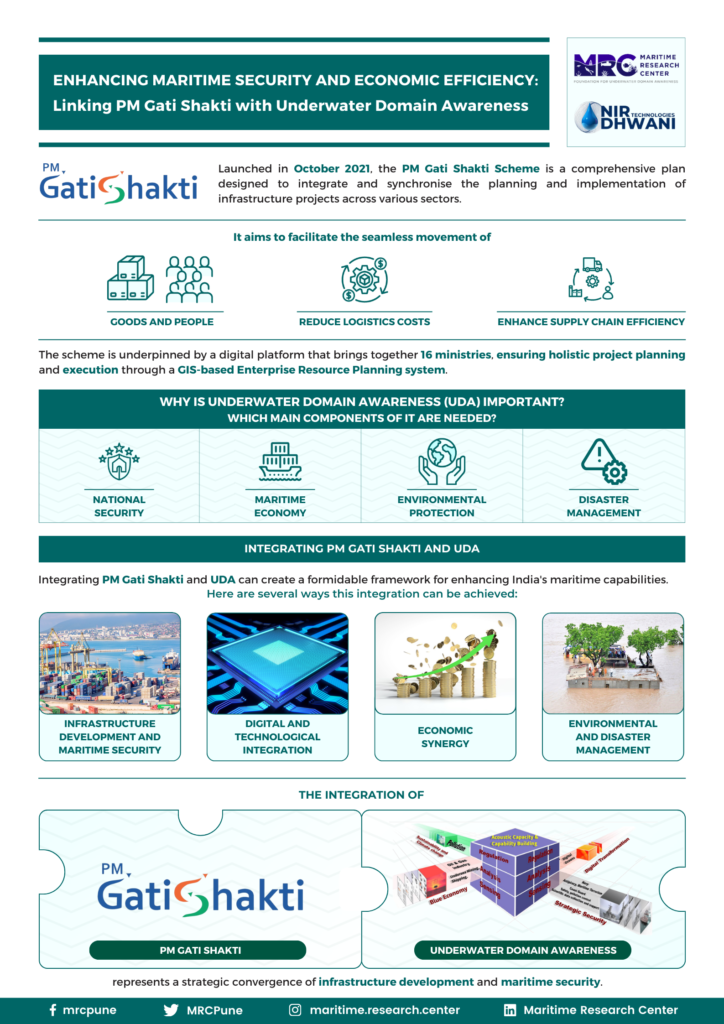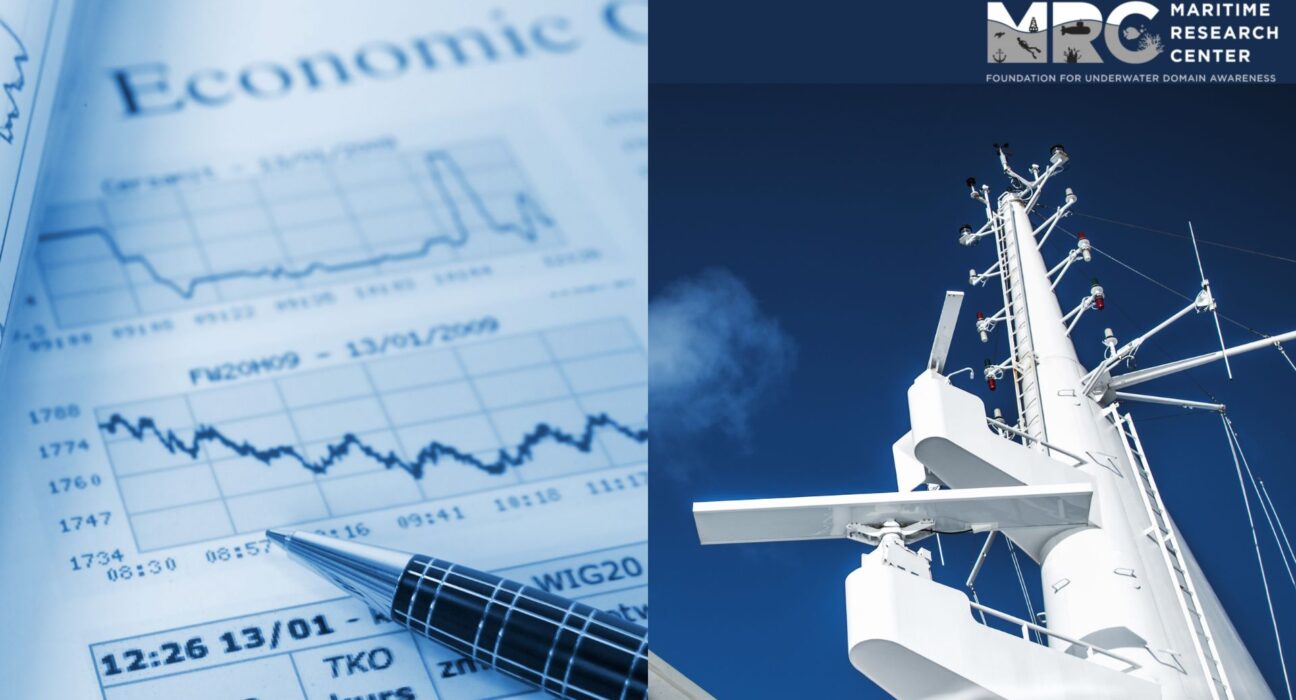- The synergy between PM Gati Shakti and UDA could revolutionise India’s maritime infrastructure and security framework.
- Integrating PM Gati Shakti and UDA can create a formidable framework for enhancing India’s maritime capabilities.
- Improved UDA can enhance early warning systems for underwater earthquakes and tsunamis, mitigating the effects of such disasters on coastal infrastructure and communities.
- Improved UDA can enhance early warning systems for underwater earthquakes and tsunamis, mitigating the effects of such disasters on coastal infrastructure and communities.
- India’s push toward a blue economy, which emphasises the sustainable use of ocean resources for economic growth, job creation, and ecosystem health, aligns perfectly with the goals of both PM Gati Shakti and UDA.
In recent years, India’s ambitious infrastructure development initiatives have taken centre stage in the country’s growth narrative. Among these, the PM Gati Shakti Scheme stands out as a transformative effort aimed at bridging infrastructural gaps, enhancing logistics, and boosting economic efficiency. Simultaneously, as India fortifies its maritime capabilities, Underwater Domain Awareness (UDA) emerges as a critical component of national security and blue economy enhancement.
Significance of the PM Gati Shakti Scheme
Launched in October 2021, the PM Gati Shakti Scheme is a comprehensive plan designed to integrate and synchronise the planning and implementation of infrastructure projects across various sectors. It aims to facilitate the seamless movement of goods and people, reduce logistics costs, and enhance supply chain efficiency. The scheme is underpinned by a digital platform that brings together 16 ministries, ensuring holistic project planning and execution through a GIS-based Enterprise Resource Planning system.
Why is Underwater Domain Awareness (UDA) important? Which main components of it are needed?
Underwater Domain Awareness refers to the comprehensive understanding of the underwater environment, which includes monitoring and analysing submarine activities, underwater infrastructure, and maritime resources. UDA is critical for several reasons:
- National Security: As underwater threats become more sophisticated, maintaining surveillance and intelligence in the underwater domain is paramount for national defence.
- Maritime Economy: Sustainable exploitation of underwater resources, such as minerals, oil, and gas, can significantly boost the economy.
- Environmental Protection: Understanding the underwater environment is essential for conserving marine biodiversity and addressing climate change and pollution challenges.
- Disaster Management: Accurate UDA can help predict and mitigate the impact of natural disasters, such as tsunamis and underwater earthquakes.
Integrating PM Gati Shakti and UDA
Integrating PM Gati Shakti and UDA can create a formidable framework for enhancing India’s maritime capabilities. Here are several ways this integration can be achieved:
Infrastructure Development and Maritime Security: The development of ports, coastal infrastructure, and maritime logistics hubs under PM Gati Shakti can be aligned with UDA initiatives. Enhanced underwater surveillance systems can be integrated into port infrastructure to monitor and secure underwater activities, thus safeguarding against potential threats.
Digital and Technological Integration: PM Gati Shakti’s GIS-based planning and coordination platform can be expanded to include UDA data. Data-driven policy interventions through Marine Spatial Planning (MSP) will go a long way in nuancedly managing the challenges and opportunities. This integration can provide real-time insights into underwater activities, facilitating proactive maritime security and disaster management measures. Advanced technologies such as underwater drones and sensor networks can gather data, which can then be analysed and utilised through the Gati Shakti digital platform.
Economic Synergy: Efficient logistics and transportation systems developed under PM Gati Shakti can enhance the economic viability of underwater resource exploitation. For instance, streamlined supply chains can support extracting and transporting underwater minerals, oil, and gas, contributing to economic growth. Additionally, the development of coastal economic zones can be aligned with UDA initiatives to ensure the sustainable use of marine resources.
Environmental and Disaster Management: The integration of UDA with PM Gati Shakti can play a crucial role in environmental protection and disaster management. By incorporating underwater environmental data into the planning process, infrastructure projects can be designed to minimise ecological impact. Furthermore, improved UDA can enhance early warning systems for underwater earthquakes and tsunamis, mitigating the effects of such disasters on coastal infrastructure and communities.


Current Scenario and Future Prospects
As of 2024, India is at a critical juncture in its journey toward becoming a global maritime power. The strategic importance of the Indian Ocean region, coupled with increasing maritime challenges, underscores the need for robust maritime infrastructure and security frameworks. The PM Gati Shakti scheme, focusing on holistic infrastructure development, provides an excellent foundation for integrating UDA.
Several recent developments highlight the importance of this integration:
Geopolitical Tensions: The Indo-Pacific region has become a focal point of geopolitical tensions, with major powers vying for influence. Enhanced UDA and efficient maritime infrastructure can bolster India’s regional strategic capabilities.
Blue Economy Initiatives: India’s push toward a blue economy, which emphasises the sustainable use of ocean resources for economic growth, job creation, and ecosystem health, aligns perfectly with the goals of both PM Gati Shakti and UDA. The integration of these initiatives can drive sustainable economic development while ensuring maritime security.
Technological Advancements: Rapid advancements in maritime and underwater technologies provide unprecedented opportunities for enhancing UDA. Integrating these technologies with PM Gati Shakti’s digital infrastructure can lead to innovative solutions for maritime challenges.
Concluding remarks!
This holistic approach is essential for addressing the complex challenges of the 21st century and positioning India as a leading maritime power on the global stage. As the nation continues to invest in and develop its maritime infrastructure, the synergistic potential of PM Gati Shakti and UDA will play a pivotal role in shaping a secure and prosperous future.
Policy intervention: The regional forums like the Indian Ocean Rim Association (IORA) and the Bay of Bengal Initiative for Multi-Sectoral Technical and Economic Cooperation (BIMSTEC) are potent for India to take the lead and drive the UDA framework. In 2015, Prime Minister Narendra Modi announced the Security and Growth for All in the Region (SAGAR) vision to create more strategic activities in oceans. Megaprojects like the Sagarmala, Bharatmala, Inland Water Transport, Gati Shakti, Deep Ocean Mission, and many more have been announced to complement the SAGAR vision.
Technology Intervention: Marine Spatial Planning (MSP) has become the de facto governance tool for marine and freshwater systems. Data-driven policy interventions will go a long way in nuancedly managing challenges and opportunities. Real-time inputs and precise prediction tools are the keys to effective interventions across applications.
Acoustic Capacity and Capability Building: The underwater medium only supports acoustic signals; thus, the acoustic survey is the de facto method for underwater domain awareness. Tropical waters require significant Indigenous efforts to mitigate the medium’s impact. The acoustic capacity and capability-building exercise across varied stakeholders and decision-makers would require a nuanced approach. The outreach, engage, and sustain approach is the only way forward.

Nishtha Vishwakarma
About Author
Nishtha Vishwakarma leads the Communications and Outreach team at the Maritime Research Center. She is also the Editor of MRC’s UDA Digest platform, which is an e-magazine dedicatedly run by the Think Tank. She is an experienced Communications professional with a demonstrated history of working in the public policy and advocacy domain. She completed her post-graduation in Public Relations and Corporate Communications at XIC, St. Xavier’s College, Mumbai. She recently finished her stint as a Broadcast Media Researcher at India’s Public Service Broadcasting Unit, DD India (International Media Channel of Doordarshan).


